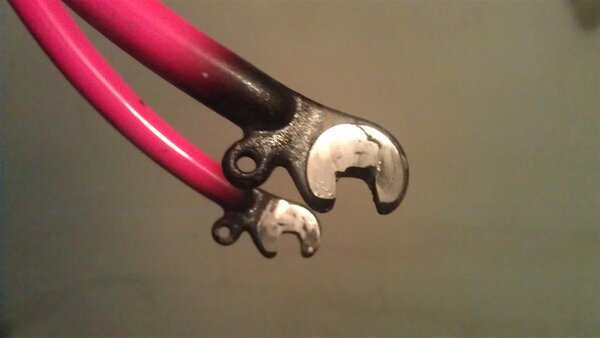Well I got my forks back from the garage over the road tonight, and they've done a cracking job! I need to file down a little more material from the inside, but they filled in the bodge from before, ground the sides down flat again, and charged me nowt, so I can't complain at all! here they are, as I picked them up. Will find a few minutes this week to file the slots a bit more and get them even, so the wheel sits straight.
You are using an out of date browser. It may not display this or other websites correctly.
You should upgrade or use an alternative browser.
You should upgrade or use an alternative browser.
Filed down fork tips - opinions please!
- Thread starter foz
- Start date
So I've started filing the excess in the slots to make the axle set nicely and the wheel sit central between the fork blades, and I've noticed that while the rim is now central between the fork blades, it's with the axle a couple of mm further into the slot on one side than the other. If I file both slots the same length, then I think the wheel won't be straight... what's the best way to check that I've got everything OK, and the wheel sits correctly, before I send them for painting?
Re:
If the rim is central both ways round, then you could have one blade more curved than the other, possible reason for someone trying to correct it.
I would say the forks were better before the welding, which is never the way to repair frames that are brazed.
Keith
If the rim is central both ways round, then you could have one blade more curved than the other, possible reason for someone trying to correct it.
I would say the forks were better before the welding, which is never the way to repair frames that are brazed.
Keith
thanks Keith. I know welding a brazed frame isn't the best idea, but while close the the dropout/blade joint, it wasn't actually on it, and was a very quick job just to add some material, rather than welding all around a joint seam. The use the bike will be put too, I'm not worried. I've checked the fork by eye, and it all appears good, so I think if the wheel lines up OK, then it's good to go.
What's the simplest way to check/measure fork alignment, other than by eye?
What's the simplest way to check/measure fork alignment, other than by eye?
Re:
I'm sure its perfectly safe, decent old bikes had a pretty good margin of strength.
I had a fork jig that was made as a one off by toolmakers about 1949. Also used a home made steel t-square. I used to be able to track them up to about 1/16th inch by eye. Compared to ordinary Raleigh bikes, the 531 fork blades were 4 or 5 times tougher to pull. This was in the 1950/60s.
The fork jig would show the deviation, but otherwise very difficult to see if one blade has curved more than the other.
Keith
I'm sure its perfectly safe, decent old bikes had a pretty good margin of strength.
I had a fork jig that was made as a one off by toolmakers about 1949. Also used a home made steel t-square. I used to be able to track them up to about 1/16th inch by eye. Compared to ordinary Raleigh bikes, the 531 fork blades were 4 or 5 times tougher to pull. This was in the 1950/60s.
The fork jig would show the deviation, but otherwise very difficult to see if one blade has curved more than the other.
Keith
I've used a flat table to set them on and check, and can't see any difference between the legs. The crown appears to be aligned with the hub too, when the wheel is fitted. I rode the bike before buying it, and it tracked OK. So I think I'll just make sure the wheel is centered and far enough into the slots to be well clamped, and be done with it.
Hopefully get it done tomorrow and taken for painting this week!
Hopefully get it done tomorrow and taken for painting this week!
Similar threads
- Replies
- 38
- Views
- 3K
Latest posts
-
-
-
-
Good tyres are expensive. Who else does skids on them anyway?😃
- Latest: Bike Hoarder
-
